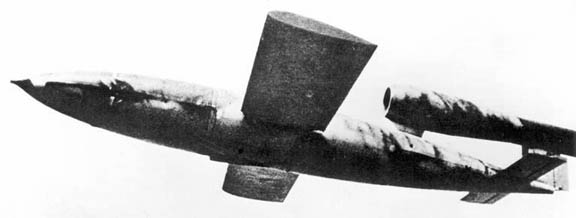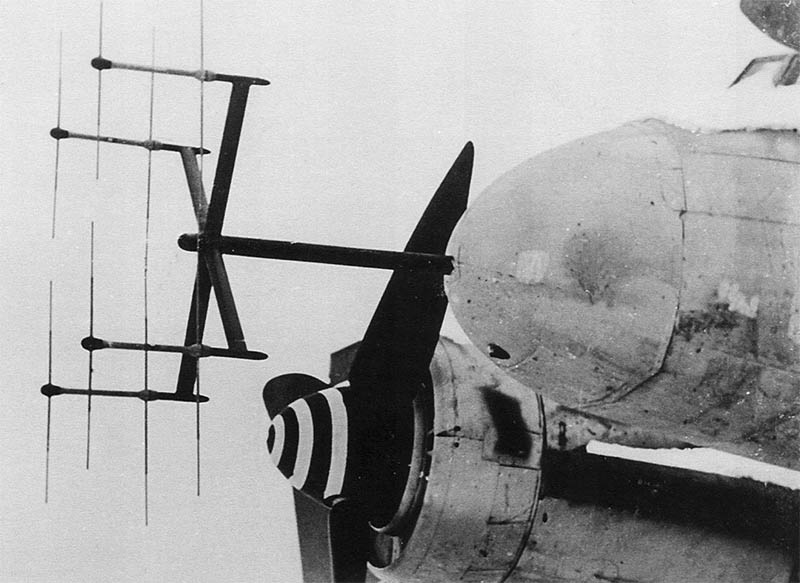by Emmanuel Gustin
- Surface-to-Surface missiles
- Air-to-Surface missiles
- Surface-to-Air missiles
- Air-to-Air missiles
- Anti-Tank missiles
- Radar and ECM
- Aircraft Guns
- U-Boot warfare
Surface-to-Surface Missiles
A-4
The A-4, also known as the V-2, was a ballistic missile. Its rocket engine used liquid oxygen and alcohol, pumped in the thrust chamber by specially developed turbopumps. The V-2 could carry its 910kg warhead at distances up to 320km. Once launched it could not be intercepted. The launchers were mobile, including a so-called Meillerwagen to carry the missile itself. Slave workers in underground plants produced about 10,000, but less than half were actually fired, primarily at London and Antwerp. Planned developments included the winged A-4b and the intercontinental A-10. The A-4 was extensively tested by the allied after the war, and the engineers who developed it contributed to later ICBM and space programmes. However, the V-2 was probably a failure as a weapon, because its cost was too high compared to the damage it did.Fieseler Fi 103

Rheinbote
The Rheinbote was a four-stage, unguided long-range artillery missile. It was a solid-fuel missile with very slim proportions. It was 11.4m long, weighed 1715kg at launch, and had a range of 215km. Its warhead was only 44kg. About 200 were fired at Antwerp in late 1944.V-3
The V-3 or Hockdrückpumpe was not a missile system, but an advanced gun. The concept was to accelerate a fairly conventional, big projectile by detonations of charges in multiple chambers that were spaced out along the barrel.Air-to-Surface Missiles
Blohm und Voss Bv 143
The Bv 143 was a glide bomb for anti-ship use, accelerated by a rocket engine. It was a primitive sea-skimming missile. A feeler arm was designed to keep the Bv 143 about 2m above the water, but it did not work properly, and the missile was cancelled.Blohm und Voss Bv 246 Hagelkorn
The Hagelkorn was an unpowered long-range glide bomb. It had an excellently streamlined fuselage, and wings with a very high aspect ratio. Construction of the wings was unusual: The aerofoils were made of concrete, around a steel core. Range was up to 200km if released from 10,000m. Several guidance systems were tried, including the Radieschen radar homing system. This made Hagelkorn one of the first anti-radar missiles. Over 1100 were produced before the project was cancelled.Friedensengel
The Friedensengel was a set of wings and tail surfaces, designed to extend the range of a standard 765kg air-launched torpedo. The onboard control system also freed the launch aircraft from the need to maintain the exact speed and altitude required by the torpedo. About 450 were produced.Fritz-X
Fritz-X, also known as FX-1400, was the first successful guided bomb. It consisted of a 1400kg armour-piercing bomb, fitted with four wings in a cruciform arrangement, and a tail ring with spoilers for control. It was usually carried by specially equipped Do 217 or He 177 bombers. In the launch aircraft, an operator steered the bomb to its target using a radio command link. Two hits with Fritz-X sank the Italian battleship Roma. Others seriously damaged the Italia and the British battleship Warspite, sank the cruiser Spartan, and damaged the cruisers Savannah and Uganda. Production of Fritz-X was limited to about 1400.Henschel Hs 293
This was the first guided missile that entered service in large numbers. The Hs 293 was a glide bomb of aeroplane configuration, with a underslung rocket engine. It was carried by bombers like the He 111, He 177, Do 217 or Fw 200. A radio command link was standard, and a flare in the tail burned to help the operator sighting. There were also versions with wire guidance, and the experimental Hs 293D had TV guidance. The sloop HMS Egret, on 27 August 1943, had the dubious honour of being the first ship sunk by a guided missile. Many other victims followed, including five destroyers. Over 2300 Hs 293 missiles were fired.Henschel Hs 294
Derivative of the Hs 293. It was intended as a anti-ship weapon, travelling to final trajectory to its target underwater.Henschel GT 1200
The GT 1200 was a powered glide bomb for use against ships. It was designed to dive into the water at the end of its trajectory.Mistel
The Mistel combinations consisted of a twin-engined bomber, in practice almost always a modified Ju 88, with a fighter (Bf 109 or Fw 190) mounted on top. The bomber was unmanned, its cockpit replaced by a large (3500kg) shaped-charge warhead, and additional tanks were installed to transfer fuel to the fighter. The combination was controlled by the pilot of the fighter. He would aim the Mistel at a target, then uncouple his fighter to fly back home. Over 250 were built. Plans for large scale operations, e.g. against Soviet power stations, were abandoned.Schneewittchen
This was an improvement of Friedensengel. Few were delivered.Zitteroschen
Zitteroschen was the first supersonic, winged, and guided missile. Intended for use against ground targets, it had small triangular wings and two rocket motors. It did not enter production.Surface-to-Air Missiles
Enzian
The design of Enzian was inspired by the Me 163 rocket-powered fighter aircraft. Its delta-wing layout and relatively fat fuselage were similar. It had four boost engines and a sustainer. A small number was built, but problems with the engines and the guidance system were never resolved.Feuerlilie
Anti-aircraft missile. It had a streamlined body and twin tail fins. It was powered by a rocket engine and had radio command guidance. Although development continued until the end of the war, it was never ready.Hecht
Surface-to-air missile, in development until it was replaced by more promising designs in 1941.Henschel Hs 117 Schmetterling
Of all experimental surface-to-air missiles, this one came closest to an operational weapons system. At the end of the war it was in production, but it was never operationally used. With a length of 4.29m, it was a relatively small missile. Its shape was that of a small aircraft, with a sustainer rocket engine in its body, and two boost engines, mounted above and below its fuselage. Range was about 32km, and it could be used against targets up to 10,000m high, although in such cases guidance problems were considerable: Aiming was visual, by means of a radio command link. There were also experiments with air-drops, with the use of radar for guidance, and with proximity fuses.Rheintochter
This was a large anti-aircraft missile, rather crude in design. It had four tail fins, six fins on the center body, and four canard control fins. It had a boost engine in the tail, and a sustainer in the front fuselage. Control was again visual aiming with a radio command link. Rheintochter III was smaller than Rheintochter I, but had better performance. The project was abandoned in December 1944.Taifun
This was an unguided anti-aircraft weapon. It was a simple, 1.93m long, spin-stabilized rocket with a 0.5kg warhead. Taifun was accelerated to Mach 3+, and could reach altitudes up to 15000m. It was intended to fire salvos of 30 missiles. At the end of the war it was in mass production.Wasserfall
The Wasserfall SAM was developed at Peenemüde, and was based on experience with the A-4, also known as V-2. It was smaller, but of similar shape and also powered by liquid fuels. The operator used input from radars tracking both the target and the missile to steer it, using a radio command link. A proximity fuse would ignite the 235kg warhead. The program was cancelled in February 1945, when it was close to the production stage.Air-to-Air Missiles
Henschel Hs 298
This was the world's first AAM, but it never entered production. It had the shape of a small aircraft. Like other German missiles, it used radio command guidance, although a wire-guided version was also developed. It was planned to fit a proximity fuse for the 25kg warhead. Over 300 were fired in tests. Range was about 9km.Kramer X-4
The X-4, also known as RK 344, was probably the first practical AAM. It had four wings, arranged in cruciform shape, and four small control fins. Two guidance wires were unrolled from spools on the wings. Range was about 3.5km, with the missile preferrably fired from about 1.5km distance. It had a 20kg warhead. Hundreds were test fired, and in some occasions test missiles seem to have been fired in anger. But no X-4 missiles reached operational units.R4M
This was a simple unguided rocket, with a diameter of 55mm. They were stabilized by eight folding fins. Fighters such as the Me 262 could carry wooden racks with twelve R4M missiles under the outboard wing panels. With a range of 1500m and a warhead of 0.5kg, they were very effective against allied bombers. There was also a version with an armour-penetrating shaped-charge warhead. The R4M was not used on a large scale, but after the war many airforces introduced folding-fin aircraft rockets (FFAR) based on the R4M.Anti-tank Missiles
Kramer X-7 Rotkäppchen
This was a wire-guided anti-tank missile. The X-7 had a short, fat body, large twin fins, and a trailing arm carrying the guidance wire spool. It had a 2.5kg shaped-charge warhead. Small numbers of pre-production missiles were used in combat. There was also a Steinbock version with IR homing guidance.Peipenkopf
This anti-tank missile used electro-optical guidance.Pinsel
This anti-tank missile used electro-optical guidance.Radar and Electronics
FuG 200 Hohentwiel
Anti-ship radar, installed on large maritime patrol aircraft such as the Fw 200.FuG 202 Lichtenstein BC
Nightfighter radar. Lichtenstein operated on 409MHz, had a maximum range of 4km, and a minimum range of 200m. The aerials had four masts on the nose of the aircraft, each with an X-frame on top that carried four tandems of vertical dipoles.FuG 212 Lichtenstein C-1
Nightfighter radar, a simplified and updated FuG 202. It had longer masts, with a small streamlined cap over the nose of the mast.FuG 218 Neptun
Airborne radar. Frequency could be set between 158 and 187MHz, its maximum range was 5km, its minimum range 130m. Its aerials were arranged as a single nose mast with a large X-cross, or as four masts, and a tandem set of dipoles on each tip of the cross. A small mast on top of the vertical fin was fitted for tail-warning. A version with four sets of three antennas was fitted to the Fw 190.
FuG 218 Neptun radar on a Ju 88G nightfighter.






